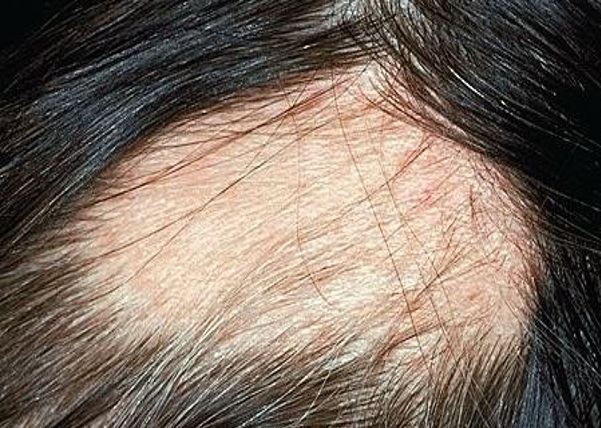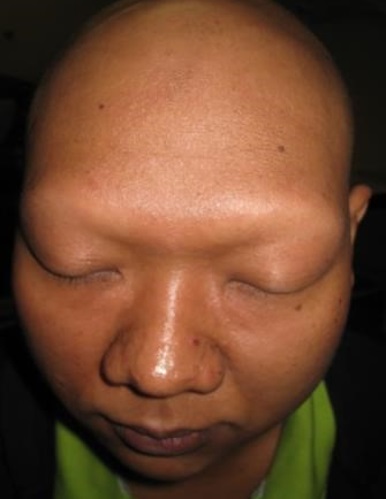What is Alopecia Areata (AA)?
Alopecia means hair loss or spot baldness.
When a person has AA, his/her hair falls out in round patches. The hair loss commonly affects the scalp, but can be elsewhere on the hair bearing area like beard, eyelashes, eyebrows, body hair, etc. Hair often grows back but may fall out again.
Who are at risk to get AA?
Alopecia areata occurs in both males and females of all ages and ethnic backgrounds, butften begins in childhood. One or two people in a thousand may get AA.
One in five people with AA have a family member with the disease as well. It is more common in people with abnormal genes or chromosomes like Down’s Syndrome.
What causes AA?
It does not spread to others. It is not due to cancer. It is also called autoimmune alopecia. Our immune system protects us by attacking germs and other invaders. It is the defender of our body.
Autoimmune means that the body’s immune system attacks the own body. The body’s immune system fails to recognize its own body cells and subsequent destruction of its own tissue as if it were an invader. What happens in AA is the immune system mistakenly attacks its own hair follicles, causing hair loss.
We are unsure how or why this exactly happens. It is likely related to our genes and some unknown trigger
People with AA may also have
- Another autoimmune disease such as thyroid disease, diabetes (Type 1), skin depigmentation called vitiligo
- Asthma and allergies
Types of AA
AA can cause different types of hair loss.
- Alopecia Areata (hair loss in patches; the most common type)
- Alopecia Totalis (lose all hair on the scalp; 5% of cases)
- Alopecia Universalis (lose all hair on the body; 1% of cases; the rarest form)
 |
| Fig 1, 2 & 3: AA of different severity (1: AA Patchy; 2: AA multifocal; 3: AA Totalis) |
What are the features of AA?
- Patchy hair loss
You maybe first be aware of the condition when you see sudden increase of clumps of hair on the pillow or in the shower drain. Sometimes you may feel or notice a bald patch incidentally. Often AA patch is discovered by a hairdresser.
The problem usually starts with single or multiple coin-sized, round, smooth, bare patch(s). Hair loss occurs mostly on the scalp. But it can affect any hair-bearing site – the body hair, eyebrows, eyelashes, beards, etc. Hair often grows back but may fall out again.
It is common to observe that one patch can be falling out while another is re-growing. Although uncommon, the disease can progress to cause total loss of hair on the scalp and body.
 |
| Fig 4: Typical picture of AA with regrowth hair (grey hair) |
 |
| Fig 5: Alopecia Totalis (Hair loss on scalp and eyebrows) |
-
“Exclamation mark” hairs
This is the most characteristic finding of AA. Often, a few short broken off hairs occur in or at the edges of the alopecia spots. These hairs get narrower at the bottom, like an exclamation mark.
- Widespread hair loss
With time, few patients may go bald over scalp and their body.
- Nail deformities
Nail disease is observed in 10–50% of those with alopecia areata. Nails can have dents (pitting), white spots or lines, and roughness or become thin and split.
How to diagnose AA?
Your doctor can diagnose alopecia areata by examining the scalp. If the patch of hair loss is expanding, your doctor may pull out a few hairs (Positive hair pull test in AA). These hairs will be looked at under a microscope.
Skin specialist (Dermatologist) may use a special instrument (dermoscope) to examine your hair and scalp to confirm the diagnosis. Sometimes the dermatologist may need to perform a skin biopsy to obtain a sample of skin with hair loss. Blood tests may be necessary if the dermatologists think that the patient might have another autoimmune disease.
How to treat AA?
In all forms of AA, the hair follicles remain alive and are ready to resume normal hair production. Hair often re-grows on its own even without treatment and even after many years.
Currently there is no acceptable treatment that works in all cases. Treatment modalities available are:
- Steroids
Sometimes a patient gets a topical form of steroid. The patient applies the medicine to the bare spots twice per day.
It can also be given as injection/shot (Intra-lesional corticosteroid injections), into the places with hair loss. Patients receive shots every 3 to 6 weeks. - Topical Minoxidil
Topical minoxidil 5% is safe and easy to use in both children and adults. Patients apply it twice a day to the affected site. New hair may start to grow in about 3 months. - Anthralin / Dithranol (short-contact therapy)
The patient applies a tar-like substance to the skin daily and leaves it on for 20 to 60 minutes. It is then washed off to avoid the skin from becoming irritated. It can cause temporary brownish discoloration of the treated skin. If new hair growth occurs, it will be seen in two to three months. - Topical Contact Immunotherapy (DPCP / SADBE / DNCB):
Chemicals such as diphencyprone (DPCP), dinitrochlorobenzene (DNCB), or squaric acid dibutyl ester (SADBE) are applied weekly to the scalp. It can take 3 months for the hair to start re-growing. - Phototherapy
Psoralen with Ultraviolet A Light (PUVA) Therapy is used if extensive AA or when other treatments cannot or do not work. - Camouflaging hair loss
If the patients feel embarrassed by hair loss, there are few measurements that can help them- Style your hair to cover the bald spots.
- Wear a wig/prosthesis, cap, hat or scarf.
- Shave the head.
- Use makeup to draw missing eyebrows.
- Counselling
Living with hair loss can be difficult. Some patients with AA may need to seek professional counselling to come to terms with the disease, regain self-confidence and build a positive self-image.
What is the outlook & prognosis of AA?
AA is not a life-threatening disease. It does not cause any physical pain and people with this condition are generally healthy otherwise. But it is a highly unpredictable condition. The disease course is different for each person.
There is every chance that the hair will regrow with or without treatment. In about 50% of AA cases, the hair regrows within a year without any treatment. But the longer the period of time of hair loss, the less chance that the hairs will regrow.
In some patients with AA, the initial hair regrowth is white or fine, with a gradual return of the original hair colour and texture. In most, the regrown hair is ultimately the same colour and texture as the original hair. No one can predict when the hair might re-grow or fall out again. There is no way to prevent the onset of AA at this moment.
References
- Messenger AG,McKillop J,Farrant P,McDonagh AJ,Sladden M. British Association of Dermatologists’ guidelines for the management of alopecia areata. BJD 2012;166(5):916-26.
- Hordinsky M,Donati A. Alopecia areata: an evidence-based treatment update. Am J Clin Dermatol.2014;15(3):231-46.
- https://www.aad.org/public/diseases/hair–and–scalp–problems/alopecia–areata
| Last Reviewed | : | 23 August 2019 |
| Writer | : | Dr.Tang Wooi Chiang |
| Accreditor | : | Dr. Azura bt. Mohd Affandi |
| Reviewer | : | Dr. Nazatul Shima bt. Abd Rahim |







